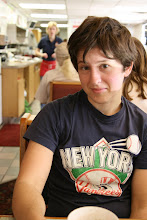


 I went to SFMOMA today to see the unveiling of Allison Smith's giant quilt. In one small gallery, along with a bunch of wooden chairs that seemed out-of-place, these photos were hung with the following caption:
I went to SFMOMA today to see the unveiling of Allison Smith's giant quilt. In one small gallery, along with a bunch of wooden chairs that seemed out-of-place, these photos were hung with the following caption:Photographs are ubiquitous in our visual culture, more so than any other form of imagery. The great majority of pictures taken since photography's invention in 1839 are functional rather than self-consciously artistic: used to document, identify, illustrate, and commemorate, such photographs have been put to uses both public (archival records, mug shots, scientific illustrations, advertisements) and private (family snapshots). This class of pictures is often called "vernacular" photography, adopting a term that originated in the field of linguistics to describe local speech patterns and was subsequently appropriated by architectural history to refer to domestic or working buildings as opposed to high style edifices.
SFMOMA was a pioneer in both collecting and exhibiting vernacular photographs, pictures that might seem to have little to do with the other forms of artistic expression in the museum displays. Yet such pictures help us to understand photography as a medium, its aesthetics and its history. A simple snapshot shows the radical act of abstraction that is performed by placing four edges around a scene, or the way the photographer can confer extraordinary importance upon an everyday object. At the same time, such quotidian pictures demonstrate the extent to which photography is an inseparable part of the social experience of modernity.
Equally important, vernacular photography-- ranging from anonymous snapshots to medical illustrations to real estate photographs-- has served as a fertile source of inspiration to artists. The American photographer Walker Evans was an avid collector of picture postcards, and his compositions often paid homage to the plain spoken quality of such humble images. Lee Friedlander in turn developed a visual vocabulary that deliberately draws on the typical "mistakes" of the amateur photographer, from the poles that frequently bisect his pictures to the inclusion of his own shadow within the frame. Like the designers of the chairs on view in this gallery, who have transformed furniture into sculptural objects, such artists have recognized the integrity and beauty inherent to photography in its least assuming form and created artwork that transcends its origins.

No comments:
Post a Comment